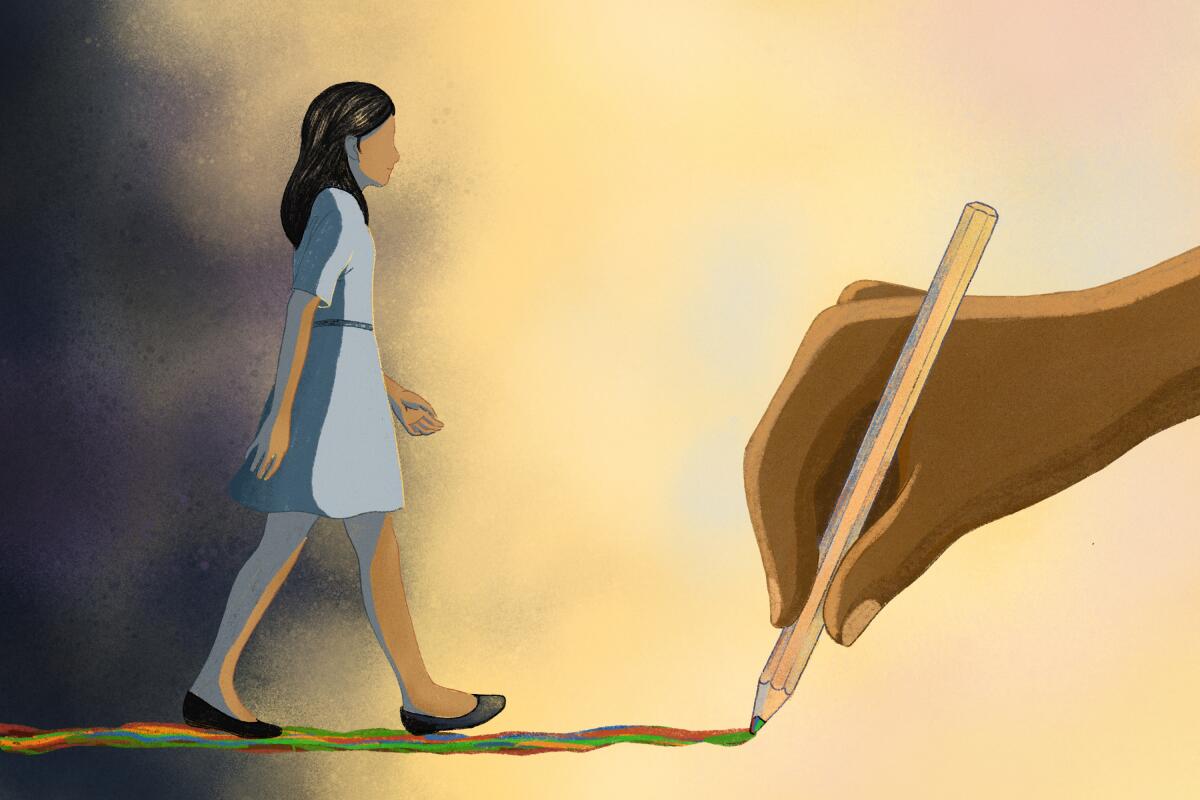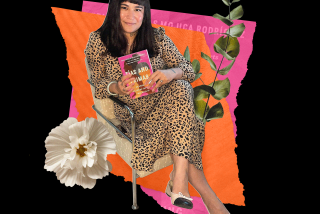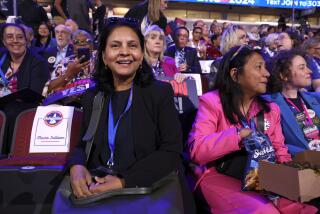Op-Ed: My Chicana-South Asian daughter, finding her roots in Karachi and south Texas

“You are South Asian,” I tell my daughter, Minal. “One hundred percent. And you are also 100% Chicana. You are both.”
Minal, a junior at a Pasadena public high school, rolls her eyes. After two years of isolation during the pandemic and our family’s recent relocation to a city where we have no family and are only just forming community, she is far from her roots.
My husband, René, and I have tried to pass down a global consciousness that links her dual identities. She has attended international baccalaureate and Spanish immersion schools, and family on both sides are a big influence. In a recent essay about her family history, she concluded that both her parents’ ancestors “experienced displacement in their lives because of colonization.”
During many dinnertime conversations at my parents’ house in Karachi, Pakistan, she has heard my parents, my journalist sister and a spate of guests discuss politics. She, too, counts as a product of the feminist and agnostic home in which I was raised. And my mother, a veteran educator, is a regular visitor to our Pasadena home.
René is a Chicano from the Texas Rio Grande Valley, where his family remained for generations even as the border shifted between Texas and Mexico. His older sister — one of the pioneers of Chicana literary criticism — begins family meals (often Tex-Mex or Chinese takeout) by dedicating gatherings to women and Indigenous communities.
René and I met in Austin. I had not planned to remain in the U.S. after graduate school, but we connected over our worldviews and family histories forged by shifting borders and displacement. We created a community in Houston where we lived for 20 years before moving to Pasadena for work.
As a transnational — someone with homes across borders — I remain close to my family in Karachi, where I don’t have to explain my identity. However, in the U.S., the superficiality of skin color and the assumptions that people make about one another are real issues. Once in Houston, when Minal was 2, I was talking on my cellphone while pushing her stroller. A white woman yelled at me, perhaps thinking I was Minal’s nanny: “Get off your phone and take care of the baby.”
More recently, I was with two writer friends in an outdoor cafe in Mid-City L.A. A woman walked up to us. Her eyes pinned on me, she commented how she liked my T-shirt that read “Resistencia: Poets Against Walls” (a writers’ collective in south Texas). Then she asked: “Where are you from?” I told her that I had moved to L.A. from Houston.
“But where are you really from?” she pushed.
My friends cringed for me. One had parents from Czechoslovakia and Ecuador. The other was born in Hawaii and had Irish and Japanese roots. But because of my dark skin, the question was posed only to me.
Since relocating to Pasadena, I’ve taught storytelling workshops for teenagers through the school district. The students who define themselves as multiracial, increasingly with parents who are both people of color, understand the meaning of intersectionality as Minal does. I’ve found that Gen Z teens will claim their identities when asked. If they feel safe, they name their parents’ ethnicities — Black, Latinx, Indigenous, white, Asian — and most add in countries where their parents were born. They list other labels that are important to their identities: queer, trans, nonbinary, bisexual, woman, cis. Many also note their passions: athlete, musician, writer, singer, activist and more.
In my writing workshops, students are often looking for paths to tell their stories, which are not reflected in their textbooks. One student, who identifies as white and Japanese, wrote about struggling with how her peers saw her: “Too Asian for the white kids. Too white for the Asian kids. Teased regardless.”
But Minal’s challenges are unique to her experience; no one we know has walked her path as a Chicana-South Asian with extended family scattered around the U.S., Pakistan, India and the globe.
I have no answers for her as she explores where she belongs in a new city. As her mother, I have to trust that she will find answers for herself. For now, René and I create opportunities for her to connect with family, which we took for granted growing up. All I can do is listen to Minal and say — as I do to my students: “You must tell your own story.”
Over the winter break, Minal and I braved Omicron and flew to Karachi for a few weeks. Experiencing the city for the first time as a young adult, Minal spent time with her cousins, one of whom is also biracial and U.S.-born, whereas the other was born in Pakistan and divides her time between the U.S. and Karachi. Minal reconnected with extended family, our house, the markets and the beach. And though she feels self-conscious when speaking Urdu, she could follow conversations.
Late one night, I heard voices from my old bedroom where Minal was with her cousins. I was about to tap on the door to remind her of the early morning outing we’d planned. I couldn’t tell what the girls were saying, but a peal of laughter cut past the door. I walked away without knocking. Her time with family in Karachi, Austin and Southern California — where our family unit is forging a new trail — might inform her in ways that textbooks never can.
Sehba Sarwar is a writer based in Los Angeles and the author of the novel “Black Wings.”
More to Read
A cure for the common opinion
Get thought-provoking perspectives with our weekly newsletter.
You may occasionally receive promotional content from the Los Angeles Times.










